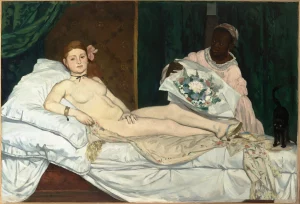Édouard Manet made a name for himself in the 1860s by becoming one of the biggest names in the burgeoning modernist movement. His works shocked audiences for several reasons, one of which was nudity. Nude figures were nothing new to the arts in nineteenth-century France, but Manet did something very different. This is best seen in some of his major paintings, one of which is finally leaving France and making its American debut at the Metropolitan Museum of Art in New York.
Olympia is a painting of a nude woman reclining on the bed. Manet first exhibited Olympia at the Paris Salon in 1865, where it was absolutely scandalous. Manet had modeled the work on Titian’s Venus of Urbino but made several major alterations. Whereas painters before used nude figures only in biblical or mythological scenes, Manet showed a sort of everyday nudity. His nude figures were not goddesses or heroines of ancient myths, but people the likes of which you could run into on the street. The public first saw this in his 1863 painting Déjeuner sur l’herbe, or Luncheon on the Grass, showing a pair of young Parisian gentlemen having a picnic in the Bois de Boulogne park with a couple of prostitutes, one bathing in the stream and the other completely nude sitting next to the fully clothed men. Salon audiences knew that these women were probably prostitutes since it was a sort of open secret that the Bois de Boulogne was where young men procured such women at the time. Olympia was another one of these paintings.
While the Venus of Urbino shows a reclining nude woman, the subject seems completely unconcerned about her nakedness. In the background, a pair of servants rummage through a chest to give her something to wear. She holds a bouquet, perhaps gifted to her by the viewer, while at her feet, there’s a small dog, a traditional symbol of fidelity. In Manet’s Olympia, the subject does not appear unconcerned; rather, many have described her expression as confrontational. She ignores the flowers her servant is giving her, while a standing black cat, a symbol of promiscuity, has replaced the resting dog. Olympia is also a large canvas for such a subject, measuring over four feet by six feet. Canvases of this size were often reserved for academic historical paintings and other more acceptable genres. Finally, there was the name. Nineteenth-century audiences may have associated the name Olympia with prostitutes. Europeans likely made this connection because of Olimpia Maidalchini, sister-in-law of Pope Innocent X, described by Théophile Gautier as “that great Roman courtesan on whom the Renaissance doted”.
In 1890, Claude Monet spearheaded an effort to buy Olympia from Manet’s widow Suzanne and then donate it to the French government. In 1907, the state finally hung the painting in the Louvre; it was moved to the Musée d’Orsay when it opened in 1986. But now, starting on September 24th, Olympia can be seen by New York audiences as part of an upcoming Met exhibition on both Édouard Manet and Edgar Degas. The Met has also managed to secure Degas’s The Bellelli Family. The exhibition, which runs from September 24, 2023, to January 7, 2024, will examine the two artists’ relationship and how it sometimes deteriorated.

